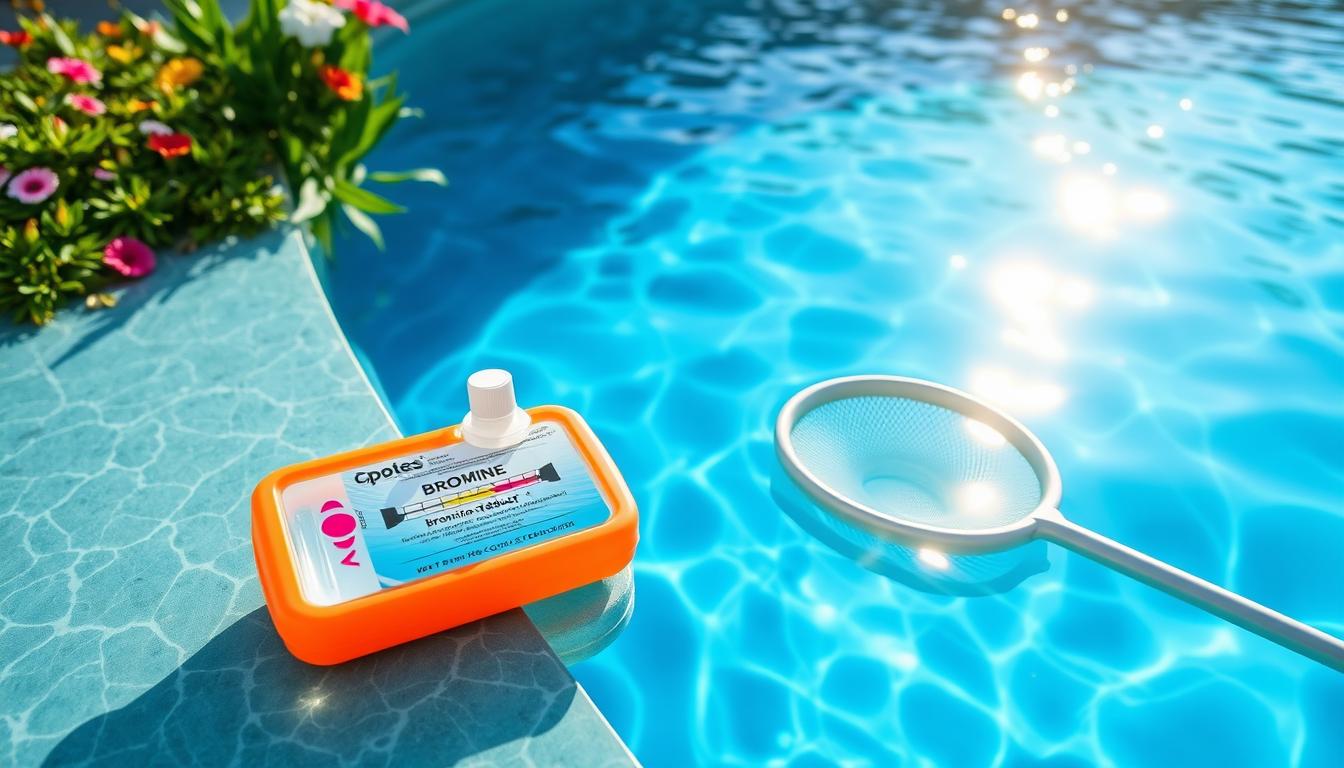
Skin irritation, red eyes, or a strong chemical smell in your pool? These may indicate high bromine levels in your swimming pool. Excessive amounts can cause discomfort and health issues. Let’s explore how to reduce bromine in your pool water and maintain safe bromine levels for swimming.
Bromine is a popular chlorine alternative for pool sanitation. It stays stable in high temperatures and has a lower pH level. The ideal bromine range for pools is 3-5 parts per million (ppm).
Levels above 5 ppm can irritate skin and eyes. They may also cause breathing problems and damage pool equipment. Proper balance is key for a safe swimming environment.
Key Takeaways
- High bromine levels can cause skin irritation, red eyes, and respiratory issues
- The ideal bromine range for pools is between 3-5 ppm
- Regularly test bromine levels using a DPD testing kit
- To lower bromine, stop adding it and use a bromine reducer like sodium thiosulfate
- Partially draining and refilling the pool can also help dilute high bromine concentrations
Understanding Bromine Levels in Your Pool
Proper bromine levels are key for a clean, safe pool or hot tub. Bromine works well in heated pools and hot tubs. It stays stable at high temps. Let’s explore ideal ranges, high-level effects, and testing tips.
Ideal Bromine Range for Pools
Pools need 3-5 parts per million (ppm) of bromine. Factors like temp and use affect the right level. Hot tubs may need 2-4 mg/litre due to higher temps.
For busy pools, aim for the higher end of the range. This ensures proper cleaning power.
Effects of High Bromine Levels
Too much bromine can cause health issues. These include skin and eye irritation, and breathing problems. Long-term exposure may lead to nerve issues.
A strong smell or swimmer complaints hint at high levels. Act fast if you notice these signs.
Regularly Testing Bromine Levels
Test often to keep your pool safe. Use a DPD kit or fresh test strips for accurate results. A chemical test kit or photometer offers even more precise readings.
Regular checks help prevent high bromine levels. This ensures a fun swim for everyone.
| Pool Type | Ideal Bromine Range (ppm) |
|---|---|
| Swimming Pools | 3-5 |
| Hot Tubs/Spas | 2-4 |
| Heated Pools | 2-4 |
Know your pool’s ideal bromine range. Watch for high-level effects. Test often. These steps help create a clean, safe pool for all to enjoy.
How to Lower Bromine in Pool
Is your pool’s bromine level too high? Don’t worry! There are effective ways to reduce it. We’ll show you how to safely lower bromine levels in your pool.
These methods will help you create a healthy swimming environment. You and your loved ones can enjoy the pool without concern.
Stop Adding Bromine
The easiest way to lower bromine is to stop adding more. Turn off your automatic brominator if you have one. Remove any bromine tablets from floaters or feeders.
This prevents more bromine from entering the pool water. The existing bromine will naturally decrease over time.
Use a Bromine Reducer
For very high bromine levels, use a bromine reducer like sodium thiosulfate. Follow the manufacturer’s instructions to dissolve the product in a clean container.
Pour the solution into the pool while the pump runs. This ensures even distribution. This method is great for lowering high bromine in pools quickly.
Partially Drain and Replenish Pool Water
If other methods fail, try diluting the pool water. Partially drain the pool and refill it with fresh water. This reduces the overall bromine concentration.
Remember to adjust other chemical levels after diluting. Check pH and alkalinity to maintain proper balance.
Utilize Sunlight and Wind
UV rays break down free bromine molecules in pool water. Wind increases evaporation, speeding up bromine dissipation. Leave your pool cover off during sunny days.
Turn off misting or fountain features. This prevents adding more bromine to the water. These natural bromine removal from pools methods are eco-friendly.
| Method | Pros | Cons |
|---|---|---|
| Stop Adding Bromine | Simple and cost-effective | Slow process |
| Use a Bromine Reducer | Fast-acting solution | Requires additional chemicals |
| Partially Drain and Replenish | Effective for extremely high levels | Time-consuming and water-intensive |
| Utilize Sunlight and Wind | Natural and eco-friendly | Dependent on weather conditions |
These strategies help with reducing bromine in pool water. They maintain a safe, comfortable swimming environment. Regularly test your pool water and adjust your treatment plan as needed.
Keep bromine levels within the ideal range. This ensures a clean and enjoyable pool for everyone.
Conclusion
Keeping ideal bromine levels in pools is crucial for safe swimming. The recommended range is 3 to 5 ppm. Regular testing helps maintain balanced and healthy pool water. If bromine levels are too high, stop adding it and use a reducer if needed.
Partially draining and refilling the pool can help lower bromine. Sunlight and wind also naturally reduce bromine concentration. Remember to check other water parameters too. Aim for a pH of 7.4 to 7.6 and total alkalinity of 80 to 120 ppm.
Calcium hardness should be between 200 and 400 ppm. Regular testing prevents issues like cloudy water and algae growth. It also helps avoid scale buildup and equipment corrosion. Balancing these factors creates a clean and inviting pool.
Stay consistent with your water testing and treatment routines. This will ensure a beautiful, low-maintenance pool that’s always ready for fun. Your family and friends will enjoy a clean, clear pool all swimming season long.







